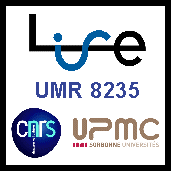EIS investigations of supercapacitor electrode materials in a two electrode configuration
Résumé
Beyond nanostructuration and deposition over substrates possessing a large specific area and acting
as current collectors, another strategy allowing the optimization of the performances of supercapacitors relies on the development of composite electrode materials. Among the elementary materials usually combined for such purpose, one can cite conducting polymers, transition metal oxides and carbon materials. By comparison with elementary materials, the resulting binary or ternary materials often provide interesting performances but these latter are not always understood and optimized in a convincing manner and they are moreover far less easily predictable than those observed for single phase materials whose basic properties are well-known and easily optimized nowadays [1]. As a consequence, the strategy based on the development of composite materials remains promising but also appears time-consuming as it seems to level-off at a trial-error type scientific procedure.
In parallel, Electrochemical Impedance Spectroscopy (EIS) has remained over many decades a powerful experimental technique for the global evaluation of the elementary electrochemical mechanisms and properties existing in electroactive materials and at their interface with electrolytic solutions. Although this technique is now very mature, its responses and their interpretation are still very often the source of controversies. This is usually the consequence of the two different methods used for the exploitation of EIS results. A first method usually consists in the qualitative interpretation of the EIS spectra leading in the best case to the poorly convincing extraction of a single parameter that is not always the most interesting one. A second one used mainly developed by EIS experts consists in the fitting of experimental results using either equivalent circuits or analytical models extracted from literature or built on purpose. The difficulty in this case stands in the fact that several equivalent circuits or analytical models allow a perfect fitting of the experimental results. The best choice is obviously the one accounting for a behaviour as close as possible to the one of the investigated electrode material.
In this contribution, two highly relevant analytical models will be applied to the fitting of
experimental spectra obtained on symmetrical supercapacitors assembled in a Swagelok type cell [2]. The electrode materials were either doped polypyrrole powders produced from a core/shell redox mechanism using nanostructured manganese dioxide powders acting as an oxidizing agent and a template simultaneously [3], and associated in some cases with PICA, or chemically reduced graphene oxide (CRGO). Both models will be tested and compared so as to establish which one is the most relevant for the various electrodes materials investigated in this work. The numerous fitting parameters will be discussed and exploited in order to develop a better understanding of the intimate properties and mechanisms occurring in these materials that explain their global supercapacitive performances.
References
[1]C. Ridruejo Arias et al., J. Phys. Chem. C, 118 (2014) 26551-26559.
[2]L. Benhaddad et al., J. Power Sources, 307 (2016) 297-307.
[3]L. Benhaddad et al., Synth. Met., 175 (2013) 192-199.

